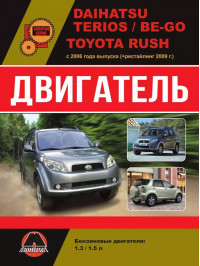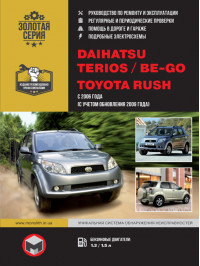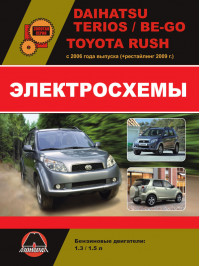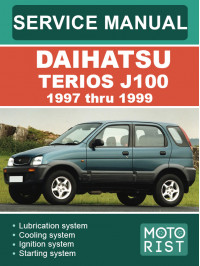Information on repair and maintenance of Daihatsu Terios cars electronically
The Daihatsu Terios is a five-door mini SUV introduced by the Japanese automaker Daihatsu at the 1997 Geneva Motor Show. When creating this model, the goal was to develop a passenger station wagon with the ability to cross off-road terrain. The car was equipped with a modified 1.3-liter HC-EJ engine producing 92 hp, taken from the Daihatsu Charade.
The car was distinguished by a fairly high ground clearance (almost 20 cm) and the presence of a driver-lockable main differential (the lock switch is located on the front panel), which made the car suitable for various types of roads. Its compact dimensions and small turning radius made it convenient for city traffic.
The first generation of the car (J100) was equipped with a 1.3-liter HC-EJ engine with 92 horsepower. In addition to the 5-door version of the J100G, another modification called the Daihatsu Terios Kid was introduced in 1998. This version had a shortened 5-door body and was sold with a 0.66 liter engine in the Japanese domestic market.
For the Japanese domestic market, the car was also produced under the Toyota Cami brand (only right-hand drive versions). However, Toyota Cami was not supplied to the markets of other countries. Models were equipped with a 5-speed manual transmission or a 4-speed automatic transmission.
In May 2000, the Daihatsu Terios underwent some changes both outside and inside. A characteristic feature was the replacement of the black plastic horizontal radiator grille with a vertical one. Inside the cabin, noticeable changes have been made, such as updates to the instrument panel, heating and air conditioning control panels, and the addition of plastic pockets in the front doors.
These models were available with two types of engines. A more advanced K3-VE engine with a volume of 1.3 liters and a power of 90 horsepower, as well as a turbocharged K3-VET with a power of 140 horsepower. The turbocharged versions were equipped with an aerodynamic body kit and had a lower height compared to the all-wheel drive versions of the J102G body. In addition, the J122G body offered rear-wheel drive versions.
Since January 2006, production of the second generation Daihatsu Terios (J200) began. In the Japanese domestic market, this car is also known under the names Daihatsu Be-go, as well as Toyota Rush (in the right-hand drive version). For the European and Middle Eastern markets, two engine options are offered: 1.3 liters with 87 horsepower and 1.5 liters with 105 horsepower. Both manual and automatic transmissions are available. In Japan, a version of the car only with a 1.5-liter engine is offered for the domestic market.
Daihatsu Terios offers options with both rear-wheel drive (2 WD) and permanent all-wheel drive (4 WD). The all-wheel drive version of this car, designed for traveling over rough terrain, is significantly superior to the more expensive and older Toyota RAV4 model in technical terms. It is important to note that the Daihatsu Terios does not have all-wheel drive.
In 2015, Daihatsu released an updated version of the Daihatsu Terios. Even though its base remains the same, the changes in design are noticeable. Externally, the car became taller and received chrome trim elements. Interior changes include the dashboard, including an updated set of controls.
In 2017, the third generation of the Daihatsu Terios (F800) was introduced. This 5-door SUV is built on the Daihatsu Xenia platform and offers 5 or 7 seats, rear-wheel drive and significant ground clearance. It's important to note that the Toyota Rush version of this model offers even higher levels of equipment.
Taking care of your car is not only the pleasure of a comfortable ride, but also responsibility for its technical condition. Regular maintenance and timely repairs are the key to long and trouble-free operation of any vehicle. It is important for Daihatsu Terios owners to be aware of the basic aspects of caring for their car, which will not only save their budget, but also ensure safety and reliability on the road.
On our website you can purchase books on repair and operation of Daihatsu Terios in PDF format. These guides contain comprehensive information to help owners independently resolve a number of issues, such as:
- Changing the engine oil
- chassis repair;
- lubrication system maintenance;
- working with electrical equipment;
- preparation for repair of the clutch pedal;
- replacing the thermostat;
- diagnostics of engine malfunctions;
- replacing the coolant pump and many others.
The Daihatsu Terios repair manual in electronic form will allow you to save your time and maintenance costs. Detailed information about the structure of the car, step-by-step instructions with detailed descriptions and illustrations will become your reliable assistants.
Experience and advice from professionals are presented in simple and accessible language, making the use of this manual recommended for any maintenance and repair needs.






